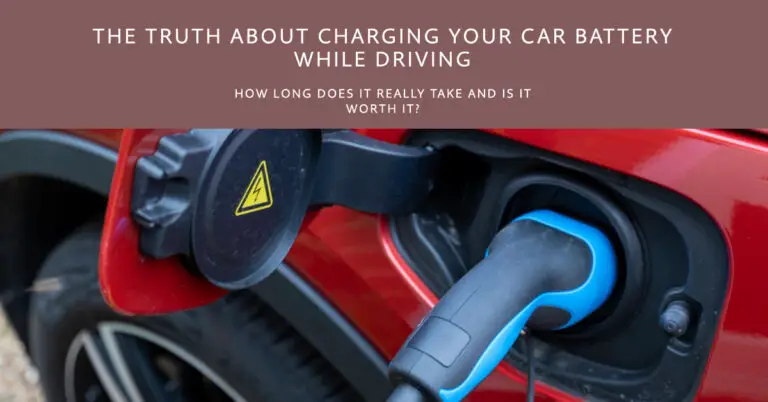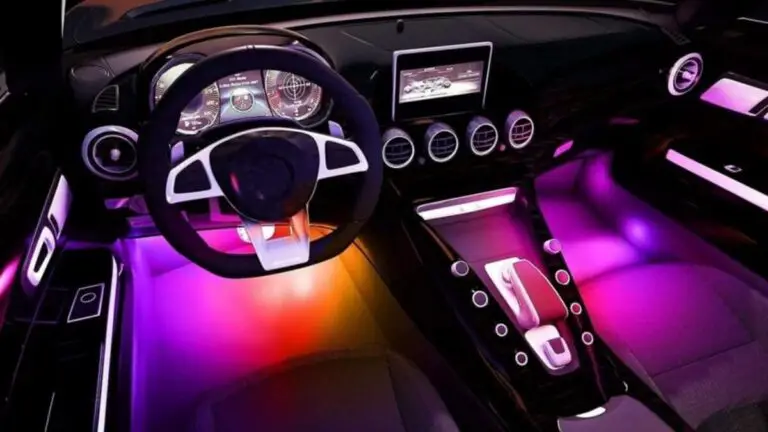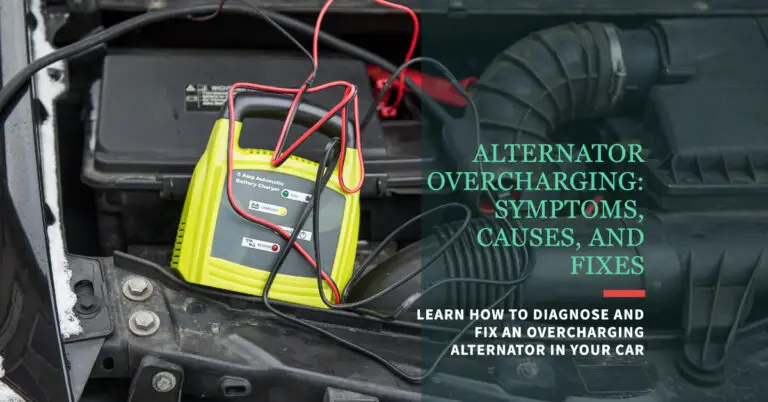How Long Does It Take to Fully Recharge a Dead Car Battery?

Do you dread getting into your car in the morning, turning the key in the ignition, and hearing nothing but a sad little click (if you’re lucky) or dead silence (if you’re not)? Few feelings drive icy spikes of panic into your chest quite like realizing your car battery is dead.
Suddenly your perfectly operational vehicle might as well be a multi-thousand-pound paperweight. So exactly how long will it take to get your car battery from completely dead back to a full charge?
The short answer is it can take 10-24 hours or more to fully recharge a dead car battery from absolute zero back up to 100%. But the actual time needed will vary based on the factors covered here.
In this comprehensive guide you’ll discover:
- The different types of battery chargers and how to choose the right one
- Recommended charging times based on the condition of your battery
- Whether you can recharge your battery by driving
- Tips to reduce charging times safely
- When it’s time to replace a dead battery
- Alternatives like jump starters if you’re in a hurry
- and much more!
So let’s dive under the hood and figure out exactly what it takes to resurrect your car’s dead battery and get back on the road.
Table of Contents
Choosing the Best Car Battery Charger
The first step is selecting the right battery charger to efficiently deliver a charge to your depleted car battery.
The most common options are:
- Trickle chargers: Provide a low amount of electrical current to gently charge small batteries over longer periods of time. Not practical for charging larger car batteries.
- Traditional chargers: Use higher amperages to deliver faster charge times. Can damage modern car batteries if settings are too high.
- Multi-stage chargers: The preferred choice. These smart chargers automatically detect battery levels and adjust current as needed to optimize recharge times while protecting battery health.
When selecting a battery charger, it’s important to match its maximum charge amperage output to the size of your car battery. This rating will be printed on the battery itself.
For a standard 50-60 Ah lead-acid car battery, a battery charger with a rating of 10-15 amps is usually sufficient. Using a charger with too high of an amperage for your battery can damage it.
Portable jump starters offer the convenience of an all-in-one battery charger, jumper cables, and power pack combo. They can be a lifesaver in charging or jump starting a dead battery, as long as they provide enough amps to start your vehicle.
How Long Should You Charge a Dead Car Battery?
If your car battery is showing absolutely zero signs of life, meaning even headlights or dashboard lights won’t turn on, then it needs some serious recharging attention.
Here are general guidelines based on the condition of your dead battery:
- 10-24 hours or more: If your battery is absolutely depleted it can easily take a full 24 hours attached to a charger to go from zero charge to holding enough power to start the car. Actual time depends on charger amp rating and other factors.
- 6-12 hours: Will revive most drained batteries to startable levels. Check voltage periodically until optimal range for starting is reached.
- 2-4 hours: May be adequate charge time if battery is not severely depleted. Always check battery diagnostics before relying solely on drive time for recharge.
The key thing to remember is there is a difference between the time needed to sufficiently recharge your battery to start your engine, and the time to fully recharge it back up to 100% capacity.
The minimum goal is getting enough juice back into the battery terminals to be able to start the car. This may happen well before a full recharge. Be patient, let the charger do its work, and periodically check voltage levels until optimal.
Can You Recharge Just By Driving?
You’ve probably heard that you can recharge your battery just by driving your car around rather than using an external charger. So is this really an effective method?
The answer is yes, technically just driving can top up a depleted battery, thanks to your car’s alternator.
The job of your vehicle’s alternator is to continuously recharge the battery while your car is running. It takes the rotational motion of the engine and converts it into the electrical current needed to power your vehicle’s electrical system.
This includes powering essential systems like ignition, fuel delivery, and all the accessory gadgets we’ve come to rely on in our cars.
The alternator isn’t a battery itself but works together as a team with your battery to handle your car’s variable electrical demands.
So if you drive long enough, your alternator will pump enough replacement amp hours back into your battery to compensate for what was drained out of it.
But there are a few important caveats:
- If your battery is very old or damaged, it may not hold a charge very well. So while you may achieve a full recharge, it will drain swiftly again after the next engine start.
- Repeatedly running your battery down to near zero before recharging risks permanently damaging cells. It’s better to combine drives with external charging to be safe.
- Short drives may not allow the charging system enough time to substantially raise your battery. Plan to drive at least 30-45 minutes to ensure your alternator can properly top up your battery’s charge levels.
In summary – yes driving can recharge your battery thanks to your car’s alternator. But it shouldn’t be solely relied upon if your battery is very depleted or worn out.
What Factors Determine Charging Times?
As the guidance above shows, charging times to resurrect a dead car battery can vary quite a bit. The major factors impacting how long it will take to fully charge your battery include:
1. Battery Type and Age
Modern car batteries come in a few common types:
- Conventional flooded lead-acid batteries
- Absorbed glass mat (AGM) batteries
- Lithium ion batteries
Lead-acid batteries are the most affordable and common choice. AGM batteries cost more but can handle increased electrical loads. Lithium batteries are the newest player – pricier but very lightweight with ultra-fast recharge capabilities.
A battery’s physical design and age affects how efficiently it can accept and retain an electrical charge:
- Older batteries may need extended charging times and reach full capacity sooner.
- Lithium technology can be replenished remarkably fast when depleted.
- Heat, cold, or damage can impact charging efficiency.
So consider your specific battery type and age when estimating charging times, not just general guidelines.
2. Electrical Load from Accessories
The more powered gadgets you have wired up in your vehicle, the faster your battery will become depleted if the car sits idle for an extended period.
Heated seats, infotainment centers with charging ports, lighting – these all steadily drain precious electricity even while parked.
So the higher the electrical load in your car, the longer it will take your battery charger to undo that energy drain and recharge back to optimal levels.
3. Ambient Temperature During Charging
Hot summer heat or subzero winter temps both interfere with efficient battery charging.
Cold battery chemistry limits the transfer of electrons while extreme heat accelerates component corrosion.
Ideally you want to charge your battery in a climate-controlled garage space, keeping ambient temperatures moderate year-round.
While temperature extremes affect all battery types, conventional flooded lead-acid designs tend to struggle the most in cold weather charging scenarios.
Tips to Reduce Car Battery Charging Time
Now that you know what makes for efficient or challenging car battery charging circumstances, let’s look at some ways to help accelerate charge times when possible.
Use a High Amperage Battery Charger
The maximum electrical current, measured in amps, that your battery charger can deliver directly impacts charging speed. Just make sure to stay within safe limits matched to your battery’s specifications.
Choosing a charger on the higher end of your battery’s recommended amperage rating will provide current faster to replenish it compared to lower amp chargers.
You definitely don’t want to overshoot though – excessive electrical current damages batteries. But when in doubt, opting for a slightly higher output charger is wise for minimizing charge times.
Disconnect the Battery Terminals
While not essential, physically detaching the negative and positive battery terminals before charging can allow for faster charge acceptance.
This safe practice eliminates any incidental power drain that could occur if accessories were accidentally left on in the vehicle.
With terminals disconnected there is zero power draw on the battery while the charger works to restore it to optimal voltage and charge capacity.
Charge Battery in Moderate Temperatures
As outlined earlier, exposing your battery to temperature extremes during charging slows the process.
When possible, move your vehicle into a climate-controlled environment or at least shade it from harsh elements.
Keeping your battery around room temperature while charging allows the charging reactions to occur efficiently.
Maintaining Batteries for Quicker Charging
Taking good care of your car battery by regular cleaning, inspection, and maintenance helps ensure it recharges swiftly when needed.
Here are some battery care essentials to practice:
- Clean terminals and connectors: Corrosion and dirt on terminals interrupts electrical flow required for charging. Use a wire brush and baking soda/water paste to clean.
- Check for cracks or leaks: Damage allows vital electrolytes to escape slowing charging speed.
- Use battery tenders: Battery maintainers keep batteries fully topped off during storage periods to avoid deep discharge.
- Let battery cool before charging: If hot from driving, allow time to cool down or charging efficiency decreases.
Showing your battery a little TLC goes a long way!
When to Replace a Battery Instead of Recharge
Sometimes no matter how long you charge a dead battery, it just never seems to revive to its former glory. If your battery is showing any of these signs, replacement may be your best bet:
Age over 5 years
Average car battery lifespan is 3-5 years. Performance declines with age making recharging progressively slower.
Repeated failure to hold charge
Despite successful charging, the battery quickly discharges again possibly due to internal damage.
Significant corrosion and casing damage
Heavily eroded terminals or cracked case means vital components have likely sustained damage affecting charging capacity.
While chargers can rescue moderately depleted batteries, those that are very old or worn have probably reached the end of their lifespan.
What If You Need an Immediate Battery Boost?
Let’s say your battery dies at the worst possible moment and you need to get back on the road ASAP. Or perhaps you use your battery charger properly but it still isn’t quite strong enough to start your engine.
In these cases, jump starting your vehicle using an emergency power boost from another battery source may be your quick ticket to being mobile again.
Here are two common options that save the day when you need an instant battery lift:
Jump Start from Another Vehicle
The classic method every driver should know – using jumper cables to connect your battery to a running vehicle with a good battery. This provides just enough extra electrical current to hopefully crank your engine.
Caveats are needing access to a generous friend with both jumper cables and a vehicle, proper safety precautions, and avoiding repeated jumps which risk damage.
Portable Jump Starter Packs
These compact devices are essentially external batteries you keep charged that can provide a powerful boost when needed. Large enough units can typically jump start most full-sized vehicles a few times before needing their own recharge.
Portable jump starters combine cables, power source, and battery charger all in one convenient emergency tool. They give you on-demand help wherever you are without relying on another vehicle. Well worth the small investment for confidence on the road.
Frequently Asked Car Battery Charging Questions
Let’s wrap up with answers to some of the most common questions drivers have about resurrecting dead and dying car batteries:
How long will a jump start hold charge?
The power boost a jump provides from cables or portable packs is just temporary. You must drive at least 30-45+ minutes for the alternator to substantially recharge your battery after jump starting. Always proceed directly to a repair shop for diagnostics after jump starting to prevent another stall out.
Can you overcharge a car battery?
It’s definitely possible to provide too much electrical current during charging. This can lead to overheating, rapid fluid evaporation, damage to internal plates, and short battery life. Always select a charger suitable to your battery’s specifications and monitor temperature and voltage during charging.
What should the voltage be on a fully charged car battery?
A good fully charged car battery will show a resting voltage around 12.6-14.4 volts on a quality digital voltmeter. Check your manufacturer specifications as reading may vary slightly by battery type. Voltage dropping below 12.4 volts indicates the battery is discharging again and needs attention.
In Closing: Key Takeaways on Car Battery Charging
Getting your car battery charged and resurrected after a stall out doesn’t have to be frustrating or mysterious. Understanding a few essential factors goes a long way:
- Properly match charger amp rating to battery size – higher amps charge faster but don’t overdo it
- Charging a dead battery to minimum starting voltage takes 6-12 hours on average
- Reach full charge capacity in 10-24 hours or more in case of deep discharge
- Driving alone may not fully recharge a run down battery so combine with charging
- Keep batteries well maintained and replaced on schedule
Show your car battery a little love and care underhood, and it will reliably turn over your engine for years of smooth starting.
Do you have any other car battery charging tips or questions? Let us know in the comments!







